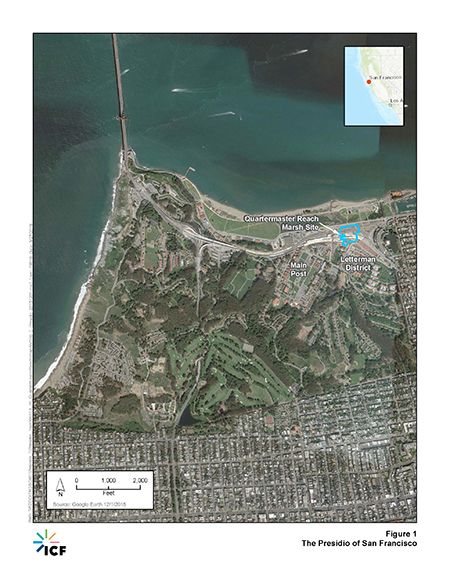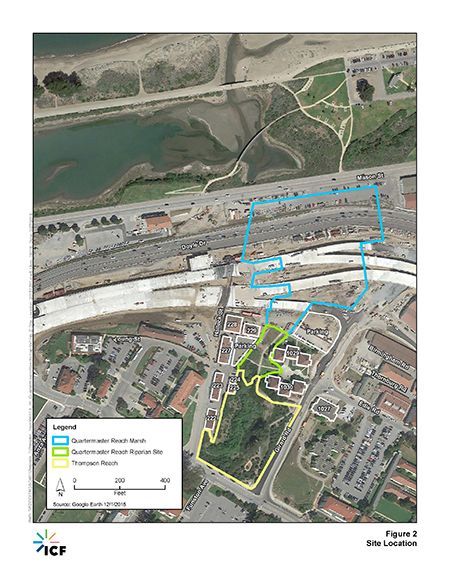Restoring a tidal marsh in an urban environment

Challenge
Since the turn of the last century, approximately 42% of tidally-influenced marsh habitat in the San Francisco Bay Area and along the California coastline has been lost to commercial, industrial, and residential development. Of particular significance is the 79% loss of associated brackish marsh habitat, which supports a varied mixture of flora and fauna and complex ecological processes due to the interchange of freshwater and saltwater.
The highly urbanized setting and the cultural and historic resource values of the Presidio posed several unique challenges to restoration of the Quartermaster Reach. The restoration was completed in concert with a redesign of a highway with three overpass exits, so marsh design had to conform with the highway routing. Further, tidal exchange and outflow of freshwater—originally planned to flow into Cissy Marsh under a bridge—is now being routed through large culverts in order to minimize disruption to a popular pedestrian route with a variety of buried utilities.

Solution
Our team of scientists and engineers worked closely with Presidio Trust and National Park Service staff throughout the entire design process as well as the on-site construction supervision and monitoring. Beginning with the initial assessment of opportunities and constraints, we worked together on the development and evaluation of designs for the channel and the marsh.
Based on the available channel gradient, valley slope, and other land use constraints, we developed a channel design within the Riparian Reach that met important characteristics, such as: rootwad installation at selected locations along the channel; log toe structures installed along the lower banks in the narrowest part of the riparian corridor to stabilize the constructed channel against excessive bank scour and lateral migration prior to establishment of vegetation; and reinforced retaining walls to minimize the steepness of the surrounding slopes.
Through a rigorous design process guided by the principles of tidal mechanics, hydraulic engineering, and applied fluvial geomorphology, the restoration team also developed a marsh design with two secondary tidal channels for marsh complexity, a variable tidal channel bottom width that decreases in the upstream direction, and placement of oyster reef balls within select hardscaped locations.
Key activities included:
- Providing hydrologic and ecological connectivity between Crissy Marsh and the Riparian Reach (as well as the upper watershed) to enable movement of terrestrial and aquatic species.
- Restoring physical features/landforms/native plant communities to create the structure necessary to support native resident and migratory wildlife.
- Establishing a gradient of native habitat types from mudflat and low marsh to upland coastal dune environments between the Riparian Reach and Crissy Marsh (including brackish areas).
- Re-establishing geomorphic and hydrologic processes to support a self- sustaining, continuous and varied native tidal and brackish marsh environment.
- Providing recreational opportunities that would not adversely affect wildlife use of the restored site.
Results
The Riparian Reach was constructed in the summer of 2015. During 2020, the Presidio Trust commenced construction of the marsh site. By daylighting an underground pipe, we designed a marsh transition reach and a functioning tidal marsh with approximately 9.5 acres of new habitat—enabling aquatic organisms to access the upper watershed while helping to contribute to the recovery of tidal habitat within the Bay Area.
A majority of the restored marsh consists of the mudflat and low marsh. These areas gradually transition to higher surfaces, such as intertidal (i.e., high marsh) and upland areas. There is also a large dune swale feature located in the northeastern corner of the site that consists of a depression in the center of a sand dune, which allows for seasonal percolation of freshwater to sustain plants that are not as tolerant of the saline conditions.
Together, the two components of this project have greatly expanded the local tidal prism in the Presidio. Aquatic organisms and terrestrial species now are able to utilize the expanded marsh surface and access the upper local watershed. In fact, various aquatic organisms were observed not long after construction, including Bay pipefish, Flat Okenia Nudibranch, and Red-eyed Medusa jellyfish. The Presidio Trust plans to monitor the overall stability, vegetation plantings, and aquatic wildlife usage for years to come.
Related work
